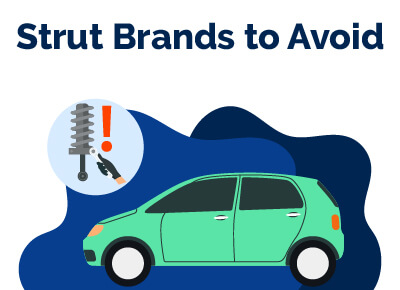Top 7 Strut Brands To Avoid
August 9, 2023


Chris is Head of Content for FindTheBestCarPrice and is based out of Philadelphia, PA. As a seasoned automotive industry analyst and car enthusiast, he ensures the highest level of quality across all our content and curates our picks for the best deals each month.
Chris studied information systems and marketing at Drexel University and writes about a wide range of topics ranging from car buying tips to troubleshooting common mechanical issues.
When he’s not thinking about cars, he likes to stay in with his dog and make an “attempt” to finish a crossword puzzle (he’s not quite at the Saturday/Sunday level…yet). As a former cheesemonger, Chris still has a “sharp” passion for all things cheese, and his fridge is always loaded with it!
Chris also has a passion for things that go fast, and drones are no exception. He spends some of his time writing for Dronesourced.
Choosing the right brand is essential when replacing the struts on your car. While there are many reputable brands on the market, there are also some that should be avoided.
Choosing a low-quality strut brand can lead to poor performance, premature wear, and even safety issues.
Let’s explore the strut brands to avoid, including those known for producing low-quality or unreliable struts. We will also provide tips on choosing the right strut brand for your car and what factors to consider when making your decision.
Whether you're a seasoned mechanic or a novice car owner, let’s learn more about the various strut brands to avoid and how to ensure your car's struts perform at their best.
Let’s get started!
Table of Contents
Strut Brands To Avoid
The following brands of struts’ quality have been called into question. There have been numerous complaints about these brands on several car forums:
1. Bavauto Struts
Several customers have reported instances where the quality of these struts could not meet their discerning standards. Some have gone so far as to label them as worthless.
These dissatisfied buyers have assigned low ratings, with scores as low as 1 out of 10, indicating the subpar performance of these struts.
The issues with this particular strut brand may not solely stem from issues of quality or unreliability but rather from a lack of demand. Few vehicle owners consider this brand reliable, resulting in its unpopularity.
BAVAUTO, as a purported brand of struts, encounters problems with its discounted or lower-priced offerings.
As per feedback from specific customers, these struts needed to meet the expected quality standards of a premium product.
The key takeaway from these observations is that opting for a non-reputable strut brand may result in disappointing performance that falls short of expectations.
2. MOOG Struts for Cars
The feedback on Moog struts for vehicles is mixed, with both positive and negative reviews.
However, most of these reviews tend to be unfavorable, giving rise to a sense of caution when considering them as replacements for your car's worn-out struts.
Given the prevalent negative reviews, it would be prudent to refrain from investing in this brand.
According to feedback from specific buyers, these struts pose challenges during installation, with reports of difficulties in mounting them.
As noted by some buyers, Moog needs to provide sufficient data regarding the required clearances for their struts, leading to issues with sway bars getting stuck or broken when attempting to disconnect them from the struts.
Furthermore, some customers have expressed dissatisfaction with the ride quality of these struts, describing them as overly stiff even when encountering minor bumps. In general, these struts need to meet the needs and expectations of these customers.
3. ACEDELCO Struts
Several vehicle owners admit to opting for these strut brands solely based on affordability.
However, their satisfaction was short-lived, as they soon realized that the quality of these struts corresponded to the low price they had paid.
These struts quickly succumbed to wear and tear, failing to endure for an extended period.
Irrespective of the mixed feedback from other buyers, whether positive or negative, these disillusioned customers have resolved to refrain from repurchasing these struts due to their disappointing experience.
According to their feedback, these struts fell far below their expectations in terms of quality.
While they may be cheaper, they were not deemed worthy of the inconvenience they caused. As such, their advice to others needing struts replacement is to avoid these particular brands.
4. OEM SACHS Struts
One of the strut brands that you should avoid is OEM SACHS Struts, despite their claims of producing high-quality struts and suspension parts.
SACHS primarily offers struts designed for BMW vehicles, but feedback from some buyers indicates that these struts may need to be more effective in larger BMW models. This presents a dilemma between price and durability when considering these options.
Furthermore, some customers have reported needing a new replacement strut after just six months of using an OEM SACHS strut. Additionally, most reviews for these struts are negative, as noted by several customers.
According to these dissatisfied customers, while these struts may be inexpensive, they could be more effective in delivering the desired performance. As a result, they strongly advise against opting for these strut brands.
5. SENSEN Shocks and Struts
This particular brand of struts ranks relatively low in the hierarchy of strut brands. One disgruntled customer ranked Sensen Struts a dismal zero out of 10, labeling them as "total junk" in their scathing review.
This dissatisfied buyer emphatically stated that the Sensen struts they purchased were garbage.
With such negative feedback, it is understandable to question the worthiness of these struts. Some customers even claim they won't last for a mere 1,000 miles, further adding to their lack of durability and reliability.
6. CEIYU Struts
The CEIYU brand of struts is known for its affordable pricing, yet customers' opinions on their performance are divided.
While some may praise them, others vehemently declare they will never use them again.
As we focus on the downsides, it's important to note that these struts have received criticism from disgruntled buyers who claim they fail to deliver value for money.
Though cheaper, the quality of these struts is often called into question. Furthermore, several customers have reported encountering unusual noises when these struts are mounted on various vehicle parts, including the rear, front, or sides.
These drawbacks are worth considering when evaluating the suitability of CEIYU struts for your vehicle.
7. KYB Struts
The criticisms about this particular brand are not limited to mere dissatisfaction with the initial ride quality but rather extend to the struts becoming excessively harsh over time.
Furthermore, customers have asserted that KYB struts may offer little durability, as after a few months of usage, every imperfection of the road becomes palpable, diminishing the overall driving experience.
Moreover, these struts may not be ideal for use with lowering springs, as even after covering a mere 2000 miles, virtually every bump on the road becomes noticeable, potentially necessitating additional expenditure on a replacement pair.
How Long Should Struts Last?
The longevity of shocks and struts depends on various factors, including the extent of wear and tear they endure, the condition of the roads traversed, the magnitude of heavy loads carried, and the driving style employed. Hence, regular inspections assume paramount significance.
Having your shocks and struts checked annually or after covering 12,000 miles in conjunction with every alignment and tire rotation is advisable. Additionally, a thorough inspection is warranted if you notice any ride-control issues or when purchasing new tires.
What To Look Out for When Purchasing Struts
The following factors can aid in streamlining your choices and identifying the optimal vehicle replacement:
- Always ensure that the mount you intend to purchase is compatible with your car. Consider your vehicle's year, make, and model while conducting your search.
- Opt for a replacement specifically designed for your automobile to ensure a seamless fit and trouble-free installation.
- Your new strut or suspension system should exhibit durability and resistance to premature wear, as it is an integral part of your car's suspension. The manufacturer and location determine the cost of the shock mount or strut.
- Aftermarket shock mounts are available at affordable prices ranging from $10 to $350, while OEM parts are more expensive. They may be sold separately, in packs, or as a set component.
- Narrow down your options by selecting manufacturers that produce struts for your specific car, and then choose the brand you trust the most. Conduct online research or seek recommendations from your technician.
Best Car Deals by Category
Frequently Asked Questions
How do I know if I need to replace my struts?
Several signs may indicate the need for strut replacement, including uneven tire wear, excessive bouncing or vibrations, nose-diving during braking, poor handling or steering response, and visible damage or leaks on the struts.
How long do strut replacements typically last?
The lifespan of strut replacements can vary depending on factors such as driving conditions, vehicle usage, and the quality of the struts. On average, high-quality struts can last between 50,000 to 100,000 miles, but regular inspections and maintenance are recommended to ensure optimal performance and longevity.
Can I replace just one strut, or must I replace all of them?
Replacing struts in pairs (either front or rear) is generally recommended to ensure balanced performance and consistent ride quality. However, if only one strut is damaged or worn out, it is possible to replace only the affected strut. Consult with a qualified technician to determine the appropriate course of action.
Can I install strut replacements or seek professional help?
While it is possible to install strut replacements yourself, it requires technical knowledge, proper tools, and experience. If you are not experienced in automotive repairs, it is recommended to seek professional help to ensure proper installation and optimal performance of the struts. Improper installation can lead to safety issues and further damage to the vehicle.
Posted in Car Buying Tips, Car Troubleshooting |




